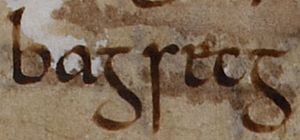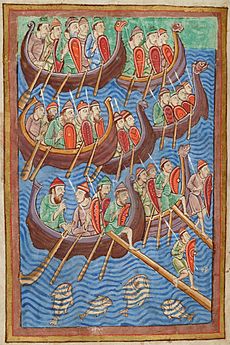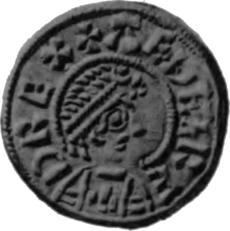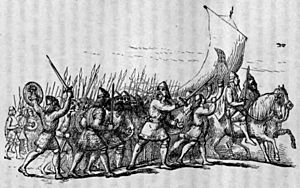Bagsecg facts for kids
Quick facts for kids Bagsecg |
|
|---|---|
| King (probably from Denmark) | |
| Reign | c.860s–871 AD |
| Successor | Halfdan Ragnarsson |
| Born | c. 830 |
| Died | approx. 8 January, 871 Ashdown, England |
| Religion | Norse religion |

Bagsecg (born around 830, died January 8, 871) was a powerful viking leader. He was one of the main commanders of the Great Army, a huge group of Vikings who invaded England.
According to old records like the Anglo-Saxon Chronicle, Bagsecg and another leader named Healfdene led the Great Army. They attacked the Kingdom of Wessex in the winter of 870-871.
The Vikings set up their camp at Reading. They fought several battles against the forces of Æthelred, King of Wessex. Bagsecg was killed in one of these battles, known as the Battle of Ashdown, along with five other Viking earls (important leaders).
After Bagsecg's death, Healfdene became the only main leader of the Great Army. He led the Vikings when they stayed in London during the winter of 871-872.
Later, some people mistakenly linked Bagsecg to an ancient burial mound called Wayland's Smithy. They thought it was his tomb or a memorial. Other old sites were also wrongly thought to be memorials for Vikings killed at the Battle of Ashdown.
Who Was Bagsecg?
We don't know much about where Bagsecg came from. He is one of the first Viking leaders whose name is written down in the Anglo-Saxon Chronicle. He and Healfdene were the first major Viking leaders mentioned by all versions of this important historical record.
His name, Bagsecg, is quite unusual. It only appears in old texts about him from 9th-century England. In comparison, Healfdene's name is much more common and means "half Dane" in Old Norse.
The Great Viking Army

Historians agree that a large Viking army came together in Anglo-Saxon England in the 860s. The oldest version of the Anglo-Saxon Chronicle calls this invading force the "micel here", which means "big army" or "great army" in Old English.
Old sources don't always agree on where this Great Army came from. The Anglo-Saxon Chronicle often just calls the Vikings "Danes" or "heathens". Some texts suggest they came from Denmark. However, other evidence and modern studies show that the Great Army was made up of different groups of warriors from various parts of Scandinavia.

Bagsecg and Healfdene likely became the main leaders of the Great Army after another important Viking leader, Ingware, left England or died. In 869, the Vikings won a big victory. They killed Edmund, King of East Anglia and took over the entire Kingdom of East Anglia. Ingware might have died around this time or moved on to fight in other places like Ireland or Scotland.
Invading Wessex

After taking over East Anglia, the Vikings turned their attention to the Kingdom of Wessex. This was the last Anglo-Saxon realm (kingdom) that was still standing against the Vikings. This might mean the Vikings wanted to weaken Wessex before a full invasion.
In late 870, the Great Army arrived at Reading, a town on the River Thames. They might have planned this attack to happen around Christmas. The Anglo-Saxon Chronicle says the Vikings fought nine battles against the West Saxons in the next few months. It describes six of these battles in detail.

Soon after setting up camp at Reading, the Great Army seemed to split up. Part of it moved further into Wessex. One battle happened at Battle of Englefield, where a West Saxon leader named Æthelwulf, Ealdorman of Berkshire defeated some Viking raiders. These raiders might have been sent by Bagsecg and Healfdene to find food or scout the area.
Four days later, the Vikings and West Saxons fought again at Reading. This time, King Æthelred, King of Wessex and his younger brother, Alfred, led the West Saxons. But the Battle of Reading ended in a defeat for the West Saxons.
The Battle of Ashdown

Just four days after their loss at Reading, the West Saxons met a large Viking force at the Battle of Ashdown. This battle took place somewhere in the Berkshire Downs. Old texts say the West Saxons were "filled with sadness and shame" and wanted to fight the Vikings. It's not clear why the Vikings chose to fight in the open. Maybe their recent victory at Reading made them overconfident.
Different old sources tell slightly different stories about the battle. The Anglo-Saxon Chronicle says King Æthelred fought the Viking group led by Bagsecg and Healfdene. Meanwhile, Alfred fought the group led by five Viking earls. This source says thousands of men were killed, including Bagsecg and the five earls. Other old texts also confirm that many people died in this very large and bloody battle.

The Anglo-Saxon Chronicle says the fighting continued into the night. This suggests the West Saxons won a difficult and long battle. One old text says the dead Vikings were spread out "over the whole broad expanse of Ashdown." Even though some sources say the West Saxons fought the entire Great Army, it's unlikely the Vikings left their camp at Reading completely unguarded. Still, it seems there were many more Viking fighters at Ashdown than in earlier battles.
Despite some different details, all the old sources agree that the Battle of Ashdown was a big success for the West Saxons. However, it might have been a "Pyrrhic victory," meaning they won, but at a very high cost. Just two weeks later, Healfdene led the Vikings to victory over the West Saxons at the Battle of Basing. Two months after that, the Vikings won again at the Battle of Meretun.
King Æthelred died soon after Easter, possibly from wounds he got in these battles. His brother Alfred then became king. About a month later, Alfred attacked the Vikings but was defeated again by Healfdene at the Battle of Wilton. The West Saxons then "made peace" with the Vikings, which probably meant they paid the Vikings to stop fighting. The Vikings then left Wessex and went to London, where the people of Mercia also paid them for peace.

After Bagsecg died, Healfdene seemed to be the only king of the Great Army for a while. The Vikings had been fighting a lot and had left many men in East Anglia. This suggests the Great Army was weaker in the spring of 871. However, news of their success in Wessex seemed to attract another Viking army to Reading. This new army joined Healfdene's men. The leaders of this new army might have been Guthrum, Oscytel, and Anwend, who are mentioned as Viking kings in 875. One or more of these men might have become kings because Bagsecg died in 871.
For hundreds of years, people wrongly connected Bagsecg to Wayland's Smithy, an ancient burial mound. They thought it was built to remember him. Other old sites, like the Seven Barrows, were also mistakenly believed to be memorials for the Viking earls killed at Ashdown. Even the Uffington White Horse, a huge hill figure from the Bronze Age, was incorrectly thought to be an Anglo-Saxon memorial to Alfred's victory at Ashdown.
|


